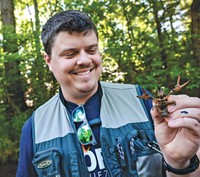Advertisement
Grab your lab coat. Let's get started
Welcome!
Welcome!
Create an account below to get 6 C&EN articles per month, receive newsletters and more - all free.
It seems this is your first time logging in online. Please enter the following information to continue.
As an ACS member you automatically get access to this site. All we need is few more details to create your reading experience.
Not you? Sign in with a different account.
Not you? Sign in with a different account.
ERROR 1
ERROR 1
ERROR 2
ERROR 2
ERROR 2
ERROR 2
ERROR 2
Password and Confirm password must match.
If you have an ACS member number, please enter it here so we can link this account to your membership. (optional)
ERROR 2
ACS values your privacy. By submitting your information, you are gaining access to C&EN and subscribing to our weekly newsletter. We use the information you provide to make your reading experience better, and we will never sell your data to third party members.
Agriculture
Newscripts
Ducks in the vineyard and cats in the infrastructure
by Craig Bettenhausen
March 4, 2023
| A version of this story appeared in
Volume 101, Issue 8

Ducks on duty
One of the many things wine aficionados look for is a sense of place in what they’re drinking: terroir, in the sommelier’s parlance. It sets two Rieslings from different vineyards apart and arises from all the specifics of how the grapes are grown. The terroir at South Africa’s Vergenoegd Löw the Wine Estate is full of ducks.

Since 1984, the vinters have kept a flock of hundreds of Indian Runner ducks, which paddle through the fields scarfing down snails. The ducks eat insects, too, but snails are the real bugaboo, because the slimy gastropods can do a lot of damage to grapevines and contaminate the grapes at harvest.
The birds aren’t just for show, though Vergenoegd’s bottle designs often feature a duck motif. Each duck eats thousands of snails over the course of a single year—completely eliminating the need for snail bait. Many vineyards fight off snails with a pesticide called metaldehyde, which can seep into groundwater and hurt other organisms.
Duck droppings also reduce the vineyard’s demand for synthetic fertilizers; a herd of Dexter cattle graze among the vines after harvest to provide another bolus of biogenic fertilizer. “This was a strategic decision to farm naturally, sustainably, and run the estate on the principles of regenerative agriculture,” a Vergenoegd representative tells Newscripts via email. “We are convinced that the ultimate benefits far outweigh short-term cost implications and that using the ducks contributes to the estate’s overall carbon footprint reduction.”
Birds can be more work than bottles of pesticide, however. Vergenoegd workers supplement the ducks’ snail feast with conventional bird feed, for example, and keep them away from the vines near harvest time. “They only work in the vineyards when grapes are still growing and when the grapes have been harvested,” the vinter says. “That’s so they do not eat the ripe grapes (which they would).”
Kitty engineers

Cats have an even longer résumé in the pest control industry, but the US Army Corps of Engineers (USACE) is instead putting them to work as calendar models.
Sitting contentedly in the USACE digital library between a presentation about public works permitting and a fact sheet about New York State’s Almond Lake dam, the 2023 Cat Calendar was quietly published by the Corps’s office in Portland, Oregon, in October 2022.
Each month features one or more giant cats Photoshopped onto project and infrastructure sites around Oregon. In March, it’s a kitten peeking over the Green Peter Dam, a 2 h drive south of Portland. In May, a round-faced adult cat menaces a police SWAT team practicing their rope descents at the John Day Dam on the Oregon-Washington border.
The cat calendar has won the USACE a lot of pawsitive press—a win for its creator, public affairs specialist Chris Gaylord. The project is far from a one-off for the Portland District, which has its own funky YouTube presence, complete with a lighthearted educational video series titled Dams et al. The channel’s tagline reflect its serious mission and local flavor: “You keep Portland weird, we’ll keep it engineered.”
Please send comments and suggestions to newscripts@acs.org.





Join the conversation
Contact the reporter
Submit a Letter to the Editor for publication
Engage with us on Twitter